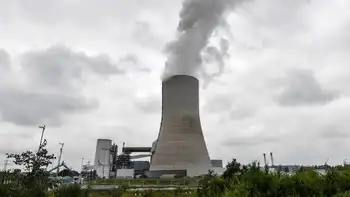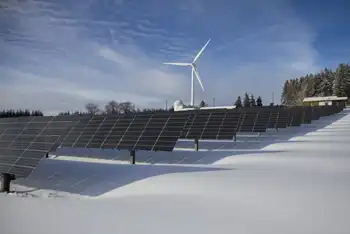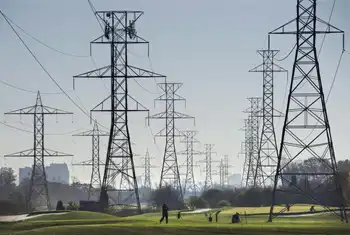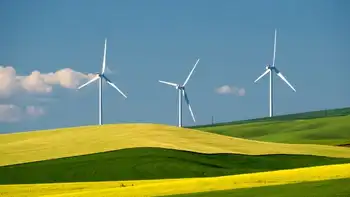Hot air: spending billions on windfarms
By Evening Standard
High Voltage Maintenance Training Online
Our customized live online or in‑person group training can be delivered to your staff at your location.

- Live Online
- 12 hours Instructor-led
- Group Training Available
A perfect symbol of what is arguably the greatest single political madness engulfing Britain today.
Although this 330ft monster will produce an income of £500,000 a year for the company that built it - nearly half of it in subsidies paid by all of us through higher electricity bills - the amount of power it contributes to our national grid will be so derisory as to scarcely register.
I know something about this turbine because I was the chairman of a group which was set up to campaign against it.
When we persuaded our local council unanimously to reject it, on the grounds that it broke all the normal planning rules, we thought we had won the argument.
But then a government inspector was sent to Somerset from London to rule that this decision had to be set aside.
All that mattered was that we must meet a target set by the EU, which requires Britain within the next 12 years to generate 38 per cent of our electricity from 'renewable' energy sources.
At present, barely 1 per cent of this country's power comes from the 2,000 wind turbines already built - less than the output of a single conventional power station.
That is why, in response to the EU's requirements, the Government is publishing its plans for a massive new drive to build thousands more turbines, at the staggering cost of £100 billion.
Here we are already into cloud-cuckoo land.
To comply with the EU's wishes, we would actually need to build at least 30,000 turbines.
In fact, as the Government knows, there is not the remotest chance that we can meet that EU target, which is why it talks about building only 10,500 new turbines - 7,000 offshore, another 3,500 across our countryside.
On its own figures, the Government is already implicitly admitting that we shall hopelessly miss our target. Of course, ministers do not tell us that.
But this is only the start of the madness. There isn't, in fact, the faintest chance that we can meet even the Government's own much smaller target.
To build those turbines offshore alone would mean lowering 7,000 colossal steel structures into the seabed, each the size of Blackpool Tower, at a rate of more than two every working day between now and 2020.
In practical terms alone this is sheer pie-in-the-sky. The technical resources are simply not available to achieve more than a tiny fraction of this figure.
But there is another important point the Government is trying to conceal about this crackpot policy, as it always does when it is talking in Walter Mitty numbers about the supposed benefits of wind power.
This is the unavoidable fact that wind speeds around the British Isles are constantly varying, often providing no power at all - so that the electricity actually generated by these turbines represents only between a quarter and a third of their nominal 'capacity'.
What this means is that conventional coal, gas, oil or nuclear-fired power stations must be on permanent stand-by to provide all the electricity the turbines are not able to produce when the wind is not blowing.
Earlier this month, Paul Golby, the chief executive of the German-owned E.ON (one of our largest electricity companies), came up with the shattering admission that the back-up needed for our new wind turbines would amount to 90 per cent of their capacity.
This alone would mean building scores more gas and coal-fired power plants, to guarantee continuous supply during those times when the wind is not blowing and therefore the turbines are not generating any electricity.
It is this which reveals the true enormity of the madness now confronting us - because Britain already faces an unprecedented crisis over its energy supplies, even before our infatuation with wind power is taken into account.
For the sum of £100 billion which the Government plans to spend on the new turbines, we could buy 37 'carbon-free' nuclear power stations at current prices, permanently supplying enough electricity to cover all our current needs.
And we need this new generating capacity right now.
Within seven years, due to the obsolescence of the existing nuclear plants (which still supply 20 per cent of our electricity) and the forced closure of nine more coal and oil-fired plants under new EU anti-pollution rules, we stand to lose well over a third of the capacity we need to meet peak demand.
This alone threatens disaster, since the Government still does not have any concrete plans in place to make up the shortfall.
We thus face the real prospect not just that our lights will go out, but that we should lose the use of the computers on which our offices, supermarkets, hospitals and transport system now depend to supply us with the necessities of life.
Yet, on top of this colossal policy failure, our Government is now babbling about a massive drive for wind power which could only make this disaster infinitely worse.
All this represents such a flight from reality that it is hard to think of any historical precedent.
The only beneficiaries from this madness are the handful of companies now looking forward to a massive bonanza, as the Government pulls out all the stops, such as further bending the planning rules, to enable them to build thousands more virtually useless wind turbines.
A great myth about wind power is that it is a 'free' source of energy.
The wind itself may be free, but the cost of harnessing it (and providing the vital backup) makes electricity from wind up to three times more expensive than that from the conventional power plants, which still provide 96 per cent of all our electricity.
The only reason why it pays developers to build turbines is the huge hidden subsidy we all give them through our electricity bills.
The electricity companies are compelled by law to buy the energy from these turbines at nearly twice the normal price - and then pass on the extra cost to us.
In years to come, we shall look back on 'the great wind scam' as having been one of the greatest blunders of our age.
But right now it seems not the slightest chink of reality is breaking in on this madness.
Our opposition parties seem just as much in its grip as those who rule us in Westminster and Brussels.
Alas, Britain's energy policy is today blowing in the wind. Literally.











